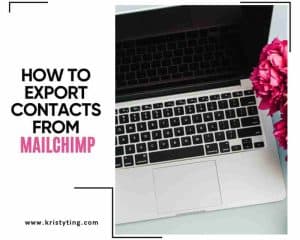This post may contain affiliate links. If you use these links to buy something we may earn a commission at no extra cost to you. Thank you for your support!
An email landing page (also known as an email capture landing page) is a dedicated landing page where you offer a lead magnet in return for your audiences’ email addresses.
The more email addresses you get, the more people you have on your email list.
Why email lists are so important is because these names are yours, and belong to you. You are not at the whim of social media platforms such as Instagram, YouTube, or Facebook — where a slight change in algorithm can immediately affect your reach, or where an unexpected account ban makes you lose your followers overnight.
Email addresses are yours to nurture, to write to, and to sell to anytime you want.
Examples of lead magnets can include anything from a free trial for software, free ebooks and PDFs, roadmaps, templates, webinars, masterclasses, and challenges.
I only recommend products I would use myself and all opinions expressed here are my own. This post may contain affiliate links that at no additional cost to you, I may earn a small commission.
What Are Email Marketing Campaigns?
This is the process of getting new subscribers to your email list and then you start emailing them on a regular basis so they eventually know, like, and trust you enough to want to buy from you.
Bear in mind that there are real humans behind every email. Your email campaigns have to be targeted, written with intent, designed to help and build a relationship, and finally be able to offer something that will really help them with whatever it is they are looking for.
Email marketing campaign in a nutshell:
- Grow your email list via paid or organic marketing campaigns by running ads, promoting on social media, and generally driving traffic to your email landing page.
- Start writing to your email list regularly. Nurture them, share value, ideas, and motivation. Build a real relationship.
- Offer them a product that you feel will really help them get unstuck or move to the next level.
But let’s start at the beginning. You want to build a good landing page with a specific offer that speaks to your target audience so that they sign up for your mailing list.
Let’s go.
Best Practices For Email Landing Page Optimization
Here are a few ways you can optimize your design and create effective landing pages.
1. Clear Message In The Headline
An email landing page can be short or long, but it is usually a single page. If you go by visual hierarchy, the first thing your audience should see is a headline that tells them what they’re currently going through — and then offer the solution for free in return for their contact details.
Here’s an example by Liz Wilcox:
Upon clicking on the button, a pop-up appears that requests your first name and email address.
A pop-up is a nice touch, especially when you get a visitor who speeds-read and tries to exit the page — the pop-up will serve as a final reminder for them to sign up to your lead magnet.
Pop-ups may not be everyone’s favorite, but they have been proven time and again to result in higher conversions (meaning more people opt-in) on email landing pages.
2. A Call To Action Button That Promotes Desired Action
So now you have a landing page and a signup form. Your contact form collects the basic information you need from your new email subscribers.
All they need is that final push. Your CTA button, correctly designed and positioned, will be an effective way of sending them over the edge (so to speak).
Let’s check out some examples:
As you can see, these CTA buttons get their audiences to take a specific action and make it sound as if the answer to their problems is just an easy click away.
3. Showing Social Proof
Social proof is a great way in promoting higher conversion rates when it comes to lead generation strategies.
Social proof or testimonials increase authenticity and authority, building trust more quickly, especially with total strangers who do not know you from Adam. The more impressive the social proof, the better.
Let’s check out a few examples of social proof on email landing pages that have blown me away in the past.
Mike Futia from Stupid Simple SEO shows how his students managed to rank on page 1 of Google after taking his course. Saleswhale, a digital marketing company shows how it helped Sage increase their conversion rates. These are on their email landing pages, where after showing you social proof, they encourage you to subscribe to them.
Include several awesome social proof on your own landing page where possible — you want to make your audiences go wow.
Social proof can be placed on a dedicated section of your landing page, or it can be scattered strategically across the whole landing page as a constant reminder of how trustworthy your brand is and how much experience you have had.
4. Clear-Cut Contact Form
The best way to get people to subscribe to you is to make it very easy for them to do so. Hence you need only the most basic contact information so that they don’t feel it’s a chore to give you their information.
Sometimes an email landing page does not even ask for names — just email addresses. Hardly any will go beyond a name and an email address — unless it is a free webinar or a free masterclass. In these cases, sometimes requesting a phone number may be required as part of the form fields so that the contact list is nurtured via text marketing as well.
5. Strong About Me Section
People want to know who they’re ‘talking’ to, or who they’re subscribing to. Readers and audiences nowadays know that the moment they give their email addresses, they’d be subscribed to a weekly newsletter (at the very least). Therefore, it matters that they know the credentials of the person who is offering the lead magnet. If they believe you can help them and they like your style, they will not mind becoming a subscriber.
An About Me page doesn’t have to be a mile long. Keep it simple and easily digestible, like the one below:
Hard facts and figures promote authenticity and trust.
Here’s another one:
Statistics show that the ‘About Me’ page is also one of the most viewed pages of any website. Therefore, many marketers put in the effort to make this specific landing page extra friendly and warm, with great copy.
Email Landing Page Examples
Now that you know what you need to have on your email marketing landing page and how a landing page works, the next thing is to know the type of landing page you need to have, along with the design that comes with it.
Designs matter when it comes to landing pages, always — because a good design keeps the audiences on the page and makes their browsing journey that much more pleasant. Many digital marketers, small businesses, and big brands will always have a budget set aside for design in their email marketing strategy.
Let’s walk through the top 4 best landing page designs and best practices.
1. White Space (one of the most basic elements of an email landing page)
A landing page needs to have enough white space to reduce distraction and increase readability. White space does not mean the background has to be white. It simply means there is an even color throughout that promotes consistency.
You can see here that the white space in Jasper is actually black. But because there is consistency, readability is much improved.
There are also brands that use Jasper, shown to you right off the bat, as social proof.
2. Mobile Optimized
In 2022, studies showed that more than 50% of web traffic came from mobile devices. It, therefore, makes sense to have your landing page completely optimized for mobile.
Since we’re talking about Jasper, here’s what it looks like on a mobile device:
3. Opt-In Or Online Form Above The Fold
Above the fold means the primary CTA or button is immediately visible upon the page loading, which also means that your reader does not have the do any scrolling to see a call to action button. It is immediately shown to them the moment the page finishes loading.
All previous examples shown here practice this design, which is extremely important to remind your readers to take action.
Here’s another example:
4. Responsive Design
A page has to be responsive and intuitive in design. This means that it is easily readable, has a proper flow to it, loads quickly without taking forever, and allows instant opt-in.
Therefore, your form builder should only ask for the name and address (occasionally a phone number, but only when really necessary). We want to keep the opt-in process incredibly fast and simple. A responsive design also increases your visibility when you’re being searched for in a search engine.
This is part of the instant gratification process so common in today’s digital marketing world. We want something, and we want it fast.
If you’re going to design your own custom landing page or have someone do it for you, ensure that you keep all these practices outlined above.
You can also add on the element of urgency (optional) such as countdown timers and limited-time special offers (with a deadline attached), especially if you’re operating an online store and want to offer a free or new product to get new customers.
Right, so now you have your email landing page goals all set. You have a great idea for a email capture lead magnet, with your online form in mind, and the type of potential customers you want to target.
The final step will be to know the types of landing page builders and tools you can use to set everything up.
Landing Page Builders And Free Landing Page Tools
Here are some of my favorite tools for landing pages.
Clickfunnels (My top pick)
One of the most popular funnel-building software in the world, Clickfunnels allows you to build amazing landing pages and has a ton of templates you can use, which are frequently being updated. It allows you to grow your email list, create courses, build automation, affiliates, and more.
Systeme.io
Systeme is free to use and is catching up to Clickfunnels fast, especially because it’s free. The designing editor still (to me) needs to be improved when compared to Clickfunnels, but overall it is a great place to start if you’re on a budget.
Go High Level
GHL is a force to reckon with. The designing editor leaves a bit to be desired, but it comes with a host of other tools such as an email service provider, automation setups, course builders, eCommerce stores, and more.
Wrapping Up
Landing pages and email marketing go hand in hand.
Your audiences opt-in on your landing page and become part of your email list.
You nurture them with weekly newsletters (some people do more, such as two or three times a week, depending on different industries), and eventually, they grow to know, like, and trust you.
You develop a relationship with them. They love your updates, you love them writing back to you and sharing their stories.
Eventually, you start offering tips, coaching calls, and consultation services. You may even sell digital courses. When you do, you give them a link in your email that sends them to a landing page (you’re right, a sales page, but a landing page nevertheless) that promotes your offer and allows them to check out using a credit card.
You then continue to grow your email list with your original lead magnet landing page, sending traffic there (organic traffic via going on podcasts, social media links, YouTube videos, and more). You can also run an advertising campaign to promote your lead magnet and create awareness about your brand, which is what a lot of big brands do.





